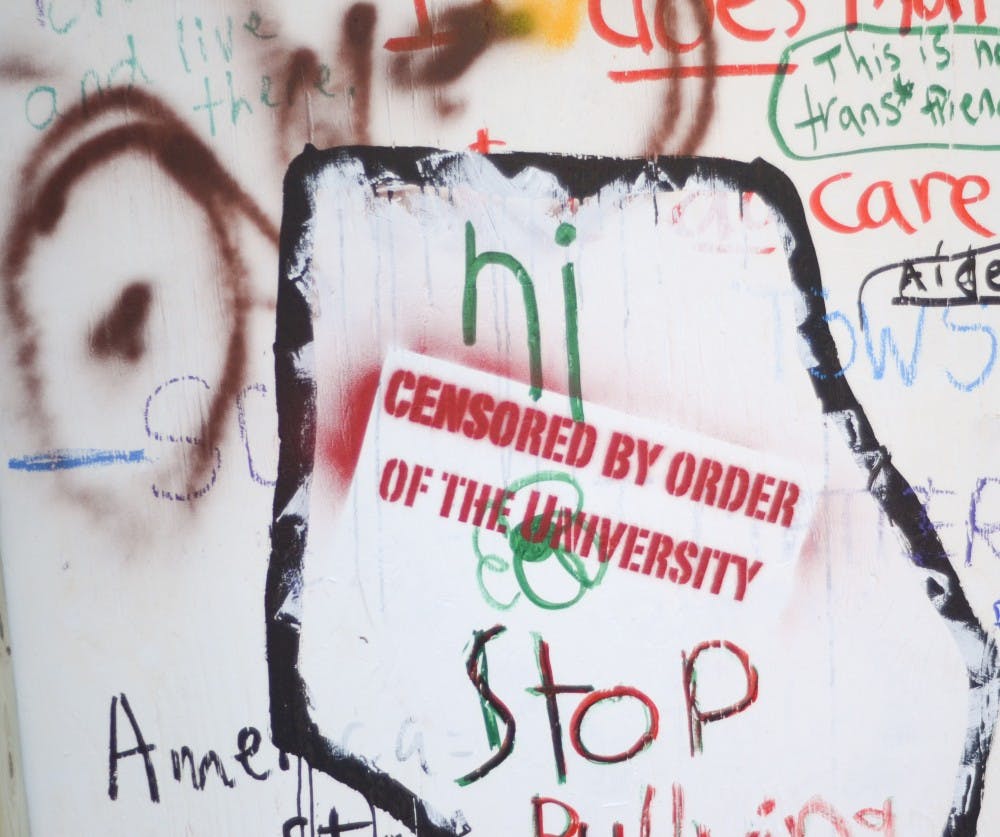The creators of a class art project that seeks responses to the question, "What can you not say at Princeton?” have reported two incidents against their project.
Known as The Surface, the creators reported one incident of "aggressive intervention” and a second incident where the University removed part of their project due to "graphic content." Both incidents allegedly happened on April 15.
The University has denied any involvement in the first incident and said the second incident was in response to a complaint it had received.
The Surface is a literal white surface where people can write and express their answers to the overarching question. At its opening, it consisted of several upright, connected white panels on the Frist North Lawn between Marx Hall, McCosh Hall and the Architecture Laboratory.
According to the project’s manifesto, anyone can write or draw on The Surface, anyone is free to censor anything written or drawn on The Surface and these rules are to be enforced by visitors and “authorized appropriators to The Surface.”
The Surface was part of the class VIS 439: Art as Interaction.
According to a report prepared by Mary Lou Kolbenschlag ’14, a member of the class, and posted on the project’s Twitter and Facebook pages, the easternmost panel of The Surface was detached sometime between 1 a.m. and 4:20 a.m. on April 15.

This panel was left on the ground. The report also states that another panel was “pried from its support post, with the screws left in a pile on the ground by the post.” This panel was not detached, and it is unknown who attempted to detach it.
The creators responded by reinstalling the detached panel horizontally in order to “reflect the appropriator(s)’ presumed intent.”
University Spokesperson Martin Mbugua said the University was aware of this incident but was not involved in the panel's detachment.
However, the University then took one of the panels away later that same day around noon, according to a separate report prepared by Kemy Lin ’15, another member of the class, together with Kolbenschlag.

Lin said the creators were not notified by the University prior to the second panel’s removal. However, Lin said they were told afterward in an email sent by manager for visual arts in the Lewis Center for the Arts Marjorie Carhart that the panel had been removed because a pedestrian had complained about a depiction of a penis painted on it.
Carhart declined to comment, deferring comment to the course’s instructor, Fia Backström.
According to the report prepared by Lin and Kolbenschlag, Al Pearson of Grounds and Building Maintenance wrote in an email that the panel would be returned under the condition that its offensive content was painted over.
In an updated report by the creators posted on the project’s Twitter page, Remi Yamazaki ’14 provided an excerpt from an email where Pearson quotes "Rights, Rules, Responsibilities" Section 1.3.7 regarding property.
Pearson did not respond to request for comment.
Mbugua said that Grounds and Building Maintenance received a report about a complaint around noon on April 15; however, he declined to comment on who issued the complaint or to whom.
Acting on the report of a complaint, Grounds and Building Maintenance moved the panel to MacMillan Building by 1:30 p.m. the same day, Mbugua explained.
In the panel’s absence, the creators placed a sign stating, “UNIVERSITY BUILDING SERVICES REMOVED THIS PANEL WITHOUT THE CONSENT OR CONSULTATION OF THE ARTISTS DUE TO APPARENT ‘GRAPHIC CONTENT.’ AN ADJUSTED PANEL WILL RETURN.”
The sign has since been removed.
The panel was returned to its original position at 7 a.m. the next day, April 16. The creators painted over the depiction of male anatomy with white paint. Where the depiction originally was, they painted, “CENSORED BY ORDER OF THE UNIVERSITY.”
Mbugua did not refer to the University taking and returning the panel as censorship. Instead, he said, “It is clear that the project has generated the interest and interaction that it intended.”
Members of the class met with University stakeholders before The Surface’s opening on April 13 to address issues of safety and placement of the project, Backström said.
Lin explained that attendants at these meetings included representatives from Building Services, Grounds Services, Conference and Event Services, Fire Safety and the Department of Public Safety.
Nathan Jones ’14 said he saw the panel before its removal while walking to class Monday morning. He said at the time, he did not know what the project was and was surprised the University had not taken it away.
Upon learning more about the project and how people are invited to censor it themselves, Jones said he considered painting over parts, but he ultimately decided not to. Instead, he contacted Buse Aktas ’14, one of the creators of the project. His comments appear in a post on the project’s Facebook page.
“It seems like people are just being immature, rather than actually expressing themselves,” Jones wrote. “Is this what The Surface was intended for, or is it being abused?"
Lin said documenting the response to the project has become part of the art of The Surface.
“Obviously, people have written some offensive things on The Surface,” Lin explained. “Our intention is not to offend or break rules. We have complied with everything the University has asked us to do. We are interested in the bureaucratic processes and how something uncommon like this interacts with the student body and the administration.”
Mbugua added that he cannot speculate on what course of action would be taken should another depiction of male anatomy appear on The Surface. He said the University would evaluate any future complaints and respond appropriately if necessary.
The Surface is a collaborative community project created by Amber Stewart ’15, Aktas, Yamazaki, Lin and Kolbenschlag.








